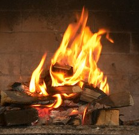Top Down Burning Start a Fire Correctly
Call Chimney Savers today for an appointment
1-800-945-0947
We can help prevent big problems
The Art of Starting a Fire
ln Your Fireplace
By Karen Lamansky
Lindemann Chimney Supply
Starting a fire in a fireplace can be tricky because some conditions are out of your control. That's why building a proper fire takes knowledge and a little creativity.
Open the Damper
The first step is to open the fireplace damper. lf your damper handle looks like a fishbone, you have the "poker" style handle. Just grab the handle and push it up, securing it in the notch that places the damper plate open the farthest. lf your damper has a "rotary" handle, you turn a knob on the fireplace facing until the damper opens. Some dampers have a reverse lever mechanism that you push away from you to push the damper plate back. Take a peek before continuing to make sure the damper plate is fully open.
A top-sealing chimney damper has a bracket and a spring handle in the firebox. A cable flows from the handle to the damper lid on top of the chimney. When the handle is secured in the bracket the lid will be in the closed position. To open the damper, pull downward and release the handle. There should be a "clunk" sound as the lid up top opens. Then, the spring handle will move upwards about 6" to 10".
Air Flow
Wait a few minutes, and then check the direction of air flow at the fireplace opening. Make sure the air is moving up the flue. lf it's coming down the flue you will most likely get smoke in your face and in the room when you light the fire.
To check you can light a match and blow it out and see which direction the smoke is moving. Or put a candle in the opening and see which way the flame moves. Or use incense. All should indicate air movement towards the fireplace / flue opening.
lf you can feel cold air coming down the flue and it's pretty strong you might want to reconsider starting a fire. lf the wind is blowing and the strength of the cold wind in your face matches the wind gusts outside, close the damper back up and call your chimney professional. You may need a special cap that prevents wind from blowing down the flue.
lf you feel a steady flow of cold air that's not too strong, you may be able to reverse the flow by preheating the flue. This can usually be done with a hair dryer or by rolling up newspapers into a cone shape, lighting it and holding it up near the damper. You should notice a lessening of the cold air downdraft within a few minutes. Once again do the draft check to make sure the air is moving towards the fireplace and up the flue.
Fire Building
My favorite fireplace log arrangement is to put two larger bottom logs parallel to each other with about 2"-3" of airspace between them. Then I criss-cross these bottom logs, setting smaller logs on top of them. These smaller logs should be parallel to each other with an air space of 1'-2”. lf I have room I place even smaller pieces on the next layer, crisscrossing three or four logs parallel to each other, then use kindling or a wax starter brick on the top. My favorite has become the wax starter brick (not the wax log). lt catches fire easily, burns cleaner than kindling and it heats things up more quickly with a longer sustained heat source.
The reason I like to go from larger logs at the bottom to smaller logs and then kindling on top is that I can set the whole fire at once. The wax brick or kindling heats up and starts to burn. Coals fall down onto the smaller logs. ln the meantime, these smaller logs are warming up and drying out. Then they ignite and the process continues with coals falling down to the logs below that are warming and getting ready to ignite. It also provides quick heat at the top of the logs to help warm up the flue and establish draft quickly.
Never use flammable liquids or other types of flammable materials to start a fire. Gasoline, kerosene, oils and other flammables can cause a structure fire. There are many uncontrollable characteristics about these and other flammable materials that can quickly get out of hand, not only causing injury, but structure fires and/or explosions.
This is all part of the art of building the perfect fire in your fireplace. Now you're ready to sit back and enjoy the warmth and ambiance of your fireplace with your family and friends.
Karen Lamansky has been involved with the hearth industry for 20 years and is the author of "Fireplace Design ldeas" published by Creative Homeowner.
Reprinted, with permission, from the January-February 2011 issue of The Chimney Sweep News an independent trade magazine for chimney service professionals. Jim Gillam, editor/publisher. 541-882-5196.
